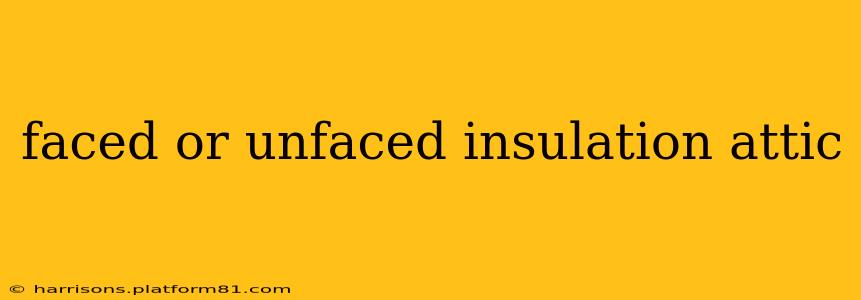Choosing the right insulation for your attic is crucial for energy efficiency and a comfortable living environment. Two popular options are faced and unfaced insulation, each with its own pros and cons. This comprehensive guide will help you understand the key differences and determine which type best suits your needs.
What is Faced Insulation?
Faced insulation comes with a protective covering, typically a kraft paper or foil facing. This facing acts as a vapor barrier, preventing moisture from entering the insulation and potentially causing damage. The facing also provides a cleaner, more finished look, making it easier to install and potentially reducing the risk of dust or fibers spreading during installation. It is often easier to handle and install due to its added strength.
What is Unfaced Insulation?
Unfaced insulation lacks the protective facing found in its faced counterpart. This makes it slightly more cost-effective. However, it requires more careful handling to prevent damage or fiber release during installation. Because it's missing a built-in vapor barrier, additional vapor barriers may need to be installed separately to prevent moisture issues.
What are the Pros and Cons of Faced Insulation?
Pros of Faced Insulation:
- Built-in vapor barrier: Reduces the need for separate vapor barriers, simplifying installation and potentially saving on material costs.
- Easier handling and installation: The facing provides structural integrity, making it easier to handle and install, particularly in tight spaces.
- Cleaner installation: Reduces dust and fiber release during installation.
- Potential for better thermal performance in some cases: The facing can reflect radiant heat, leading to slightly improved thermal performance.
Cons of Faced Insulation:
- Higher cost: Faced insulation is generally more expensive than unfaced insulation.
- Potential for moisture issues if installed incorrectly: While the facing acts as a vapor barrier, improper installation can negate this benefit and lead to moisture problems.
What are the Pros and Cons of Unfaced Insulation?
Pros of Unfaced Insulation:
- Lower cost: Unfaced insulation is typically less expensive than faced insulation.
- More flexible: Can be easily compressed and molded to fit into tight spaces.
Cons of Unfaced Insulation:
- Requires a separate vapor barrier: Additional steps and materials are required to ensure proper moisture control.
- More difficult handling and installation: Can be messy and difficult to handle, particularly in large quantities.
- Potential for dust and fiber release: More susceptible to dust and fiber release during installation.
Which Type of Insulation is Better for My Attic?
The best choice between faced and unfaced insulation depends on several factors, including:
- Your climate: In humid climates, a vapor barrier is crucial, making faced insulation a more appropriate choice. In dry climates, unfaced insulation may suffice, particularly if a separate vapor barrier is installed.
- Your budget: Unfaced insulation is more budget-friendly but requires additional materials and labor if a vapor barrier is needed.
- Your DIY skills: Faced insulation is generally easier to install, making it a better option for DIY enthusiasts.
- The existing attic structure: The ease of access and existing vapor barrier installations will inform your decision.
How Much Does Attic Insulation Cost?
The cost of attic insulation varies depending on several factors, including the type of insulation, the amount of insulation needed, labor costs, and regional pricing. You should consult with a local insulation contractor for an accurate estimate.
What is the R-Value of Attic Insulation?
The R-value of attic insulation indicates its thermal resistance. Higher R-values mean better insulation. The appropriate R-value depends on your climate and local building codes. You should consult your local building codes and energy efficiency guidelines to determine the recommended R-value for your attic.
How to Install Attic Insulation?
The installation process differs slightly between faced and unfaced insulation. Faced insulation is generally easier to install due to its inherent strength and the vapor barrier already incorporated. Unfaced insulation requires more care and potentially additional vapor barriers. It's generally recommended to consult with a professional insulation installer for the best results, especially for larger projects. However, many homeowners successfully tackle smaller insulation jobs themselves with proper research and preparation.
Choosing between faced and unfaced insulation requires careful consideration of your specific circumstances. By weighing the pros and cons of each type and considering your budget, climate, and DIY skills, you can make an informed decision that optimizes your attic insulation and improves your home's energy efficiency. Remember to always consult with local building codes and energy efficiency guidelines to ensure you are meeting all requirements.
